MGT726 Managerial Project: Employee Turnover & Organization Impact
VerifiedAdded on 2023/06/13
|32
|4798
|491
Report
AI Summary
This report investigates the impact of employee turnover on organizational performance, addressing the causes, effects, and potential solutions. It uses a descriptive research design, incorporating both qualitative and quantitative data gathered through interviews with top management, senior employees, and junior employees. The research aims to evaluate the reasons behind high employee turnover, assess its impact on overall organizational performance, and explore strategies for reducing turnover rates. Data analysis is conducted using SPSS, with results presented in tables and graphs. The study highlights the significance of employee retention for organizational success and competitiveness, referencing various studies on the financial and productive consequences of turnover.

THE IMPACT OF EMPLOYEE TURNOVER ON THE PERFORMANCE OF AN
ORGANIZATION
PROJECT REPORT.
[Put your full name here]
[Student number – I……..]
[Date]
[MGT726 Managerial Project]
School of Business
Faculty of Arts and Business
University of the Sunshine Coast
ORGANIZATION
PROJECT REPORT.
[Put your full name here]
[Student number – I……..]
[Date]
[MGT726 Managerial Project]
School of Business
Faculty of Arts and Business
University of the Sunshine Coast
Paraphrase This Document
Need a fresh take? Get an instant paraphrase of this document with our AI Paraphraser
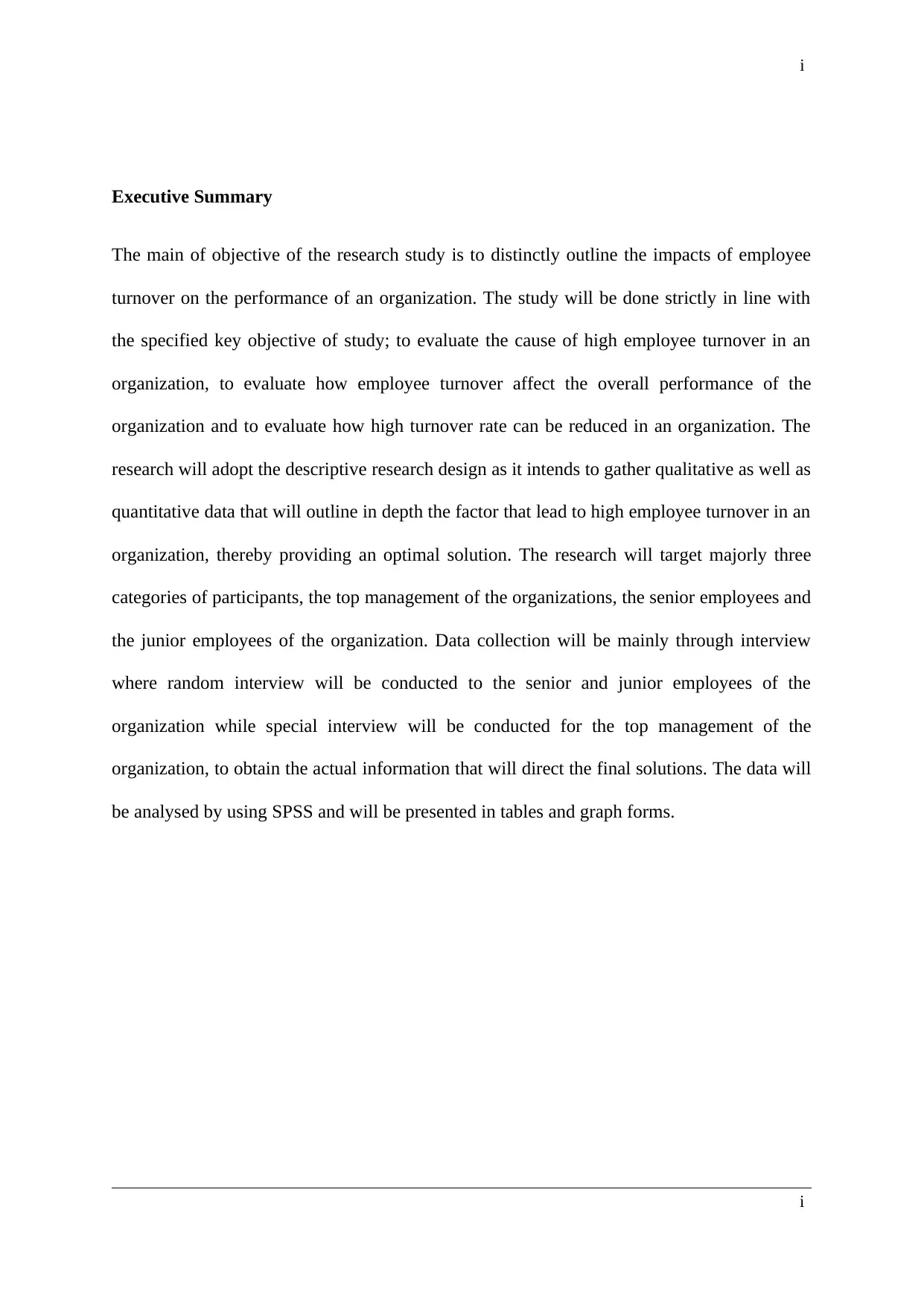
i
Executive Summary
The main of objective of the research study is to distinctly outline the impacts of employee
turnover on the performance of an organization. The study will be done strictly in line with
the specified key objective of study; to evaluate the cause of high employee turnover in an
organization, to evaluate how employee turnover affect the overall performance of the
organization and to evaluate how high turnover rate can be reduced in an organization. The
research will adopt the descriptive research design as it intends to gather qualitative as well as
quantitative data that will outline in depth the factor that lead to high employee turnover in an
organization, thereby providing an optimal solution. The research will target majorly three
categories of participants, the top management of the organizations, the senior employees and
the junior employees of the organization. Data collection will be mainly through interview
where random interview will be conducted to the senior and junior employees of the
organization while special interview will be conducted for the top management of the
organization, to obtain the actual information that will direct the final solutions. The data will
be analysed by using SPSS and will be presented in tables and graph forms.
i
Executive Summary
The main of objective of the research study is to distinctly outline the impacts of employee
turnover on the performance of an organization. The study will be done strictly in line with
the specified key objective of study; to evaluate the cause of high employee turnover in an
organization, to evaluate how employee turnover affect the overall performance of the
organization and to evaluate how high turnover rate can be reduced in an organization. The
research will adopt the descriptive research design as it intends to gather qualitative as well as
quantitative data that will outline in depth the factor that lead to high employee turnover in an
organization, thereby providing an optimal solution. The research will target majorly three
categories of participants, the top management of the organizations, the senior employees and
the junior employees of the organization. Data collection will be mainly through interview
where random interview will be conducted to the senior and junior employees of the
organization while special interview will be conducted for the top management of the
organization, to obtain the actual information that will direct the final solutions. The data will
be analysed by using SPSS and will be presented in tables and graph forms.
i
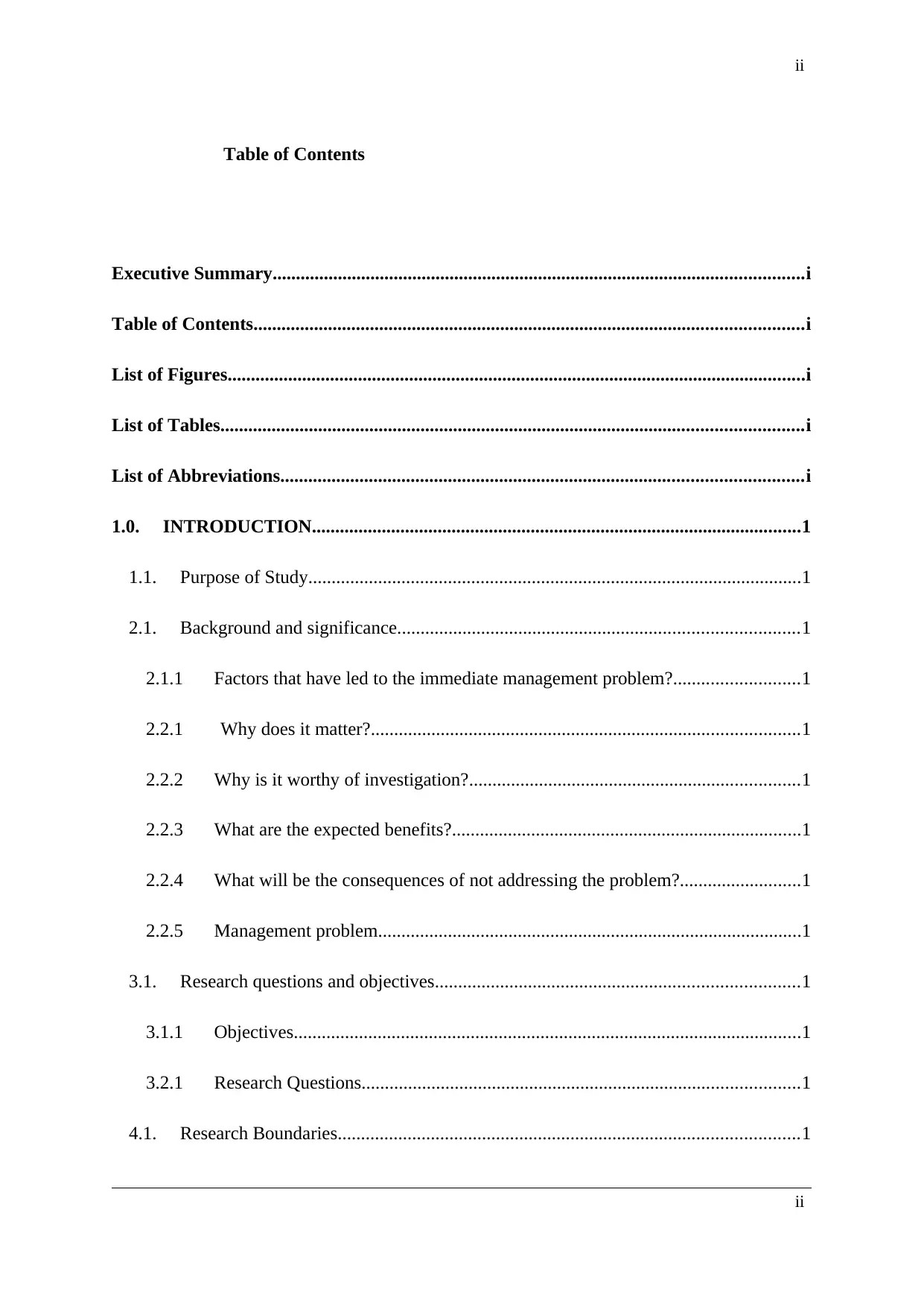
ii
Table of Contents
Executive Summary..................................................................................................................i
Table of Contents......................................................................................................................i
List of Figures............................................................................................................................i
List of Tables.............................................................................................................................i
List of Abbreviations................................................................................................................i
1.0. INTRODUCTION.........................................................................................................1
1.1. Purpose of Study..........................................................................................................1
2.1. Background and significance......................................................................................1
2.1.1 Factors that have led to the immediate management problem?...........................1
2.2.1 Why does it matter?............................................................................................1
2.2.2 Why is it worthy of investigation?.......................................................................1
2.2.3 What are the expected benefits?...........................................................................1
2.2.4 What will be the consequences of not addressing the problem?..........................1
2.2.5 Management problem...........................................................................................1
3.1. Research questions and objectives..............................................................................1
3.1.1 Objectives.............................................................................................................1
3.2.1 Research Questions..............................................................................................1
4.1. Research Boundaries...................................................................................................1
ii
Table of Contents
Executive Summary..................................................................................................................i
Table of Contents......................................................................................................................i
List of Figures............................................................................................................................i
List of Tables.............................................................................................................................i
List of Abbreviations................................................................................................................i
1.0. INTRODUCTION.........................................................................................................1
1.1. Purpose of Study..........................................................................................................1
2.1. Background and significance......................................................................................1
2.1.1 Factors that have led to the immediate management problem?...........................1
2.2.1 Why does it matter?............................................................................................1
2.2.2 Why is it worthy of investigation?.......................................................................1
2.2.3 What are the expected benefits?...........................................................................1
2.2.4 What will be the consequences of not addressing the problem?..........................1
2.2.5 Management problem...........................................................................................1
3.1. Research questions and objectives..............................................................................1
3.1.1 Objectives.............................................................................................................1
3.2.1 Research Questions..............................................................................................1
4.1. Research Boundaries...................................................................................................1
ii
⊘ This is a preview!⊘
Do you want full access?
Subscribe today to unlock all pages.

Trusted by 1+ million students worldwide
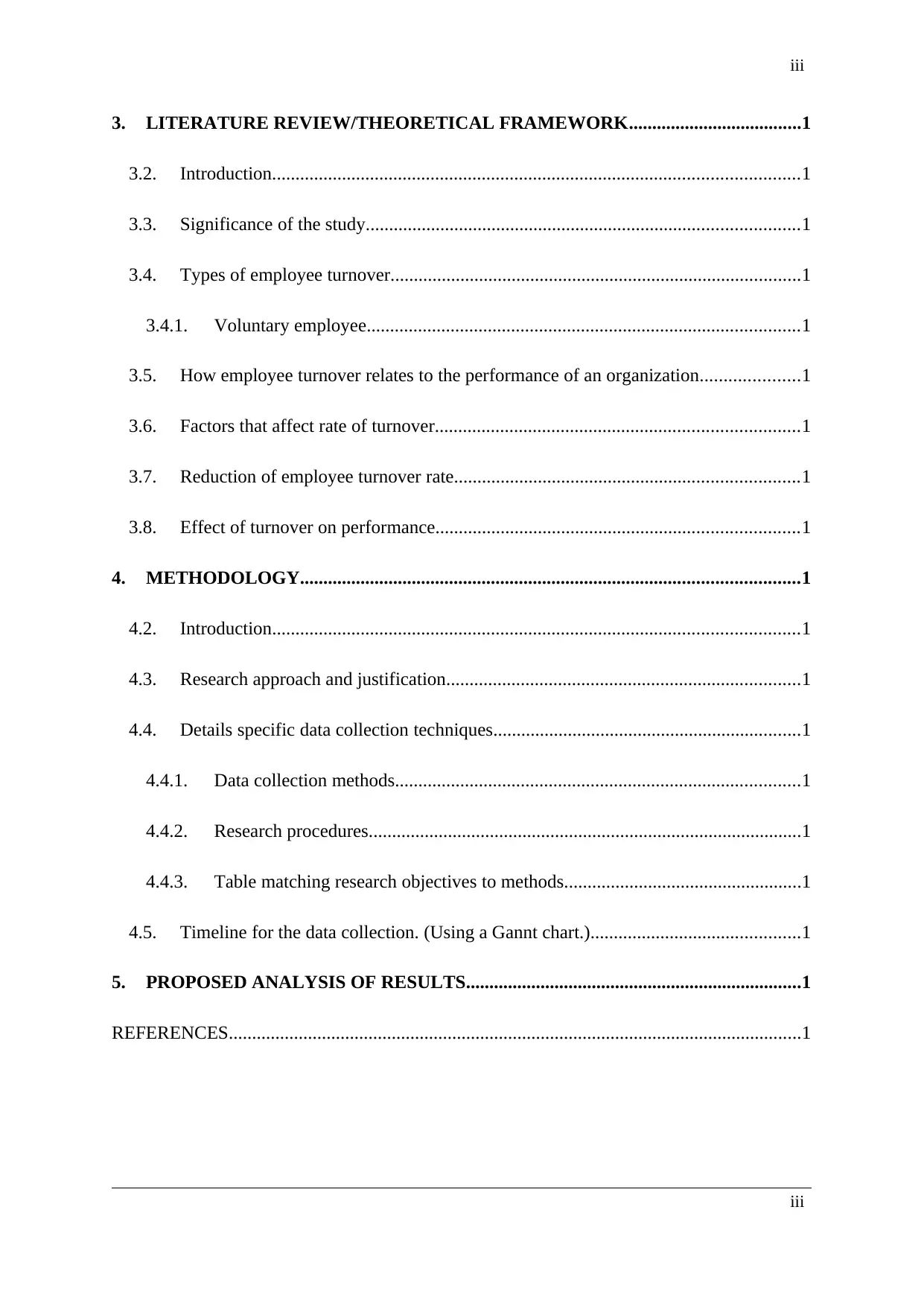
iii
3. LITERATURE REVIEW/THEORETICAL FRAMEWORK.....................................1
3.2. Introduction.................................................................................................................1
3.3. Significance of the study.............................................................................................1
3.4. Types of employee turnover........................................................................................1
3.4.1. Voluntary employee.............................................................................................1
3.5. How employee turnover relates to the performance of an organization.....................1
3.6. Factors that affect rate of turnover..............................................................................1
3.7. Reduction of employee turnover rate..........................................................................1
3.8. Effect of turnover on performance..............................................................................1
4. METHODOLOGY...........................................................................................................1
4.2. Introduction.................................................................................................................1
4.3. Research approach and justification............................................................................1
4.4. Details specific data collection techniques..................................................................1
4.4.1. Data collection methods.......................................................................................1
4.4.2. Research procedures.............................................................................................1
4.4.3. Table matching research objectives to methods...................................................1
4.5. Timeline for the data collection. (Using a Gannt chart.).............................................1
5. PROPOSED ANALYSIS OF RESULTS........................................................................1
REFERENCES...........................................................................................................................1
iii
3. LITERATURE REVIEW/THEORETICAL FRAMEWORK.....................................1
3.2. Introduction.................................................................................................................1
3.3. Significance of the study.............................................................................................1
3.4. Types of employee turnover........................................................................................1
3.4.1. Voluntary employee.............................................................................................1
3.5. How employee turnover relates to the performance of an organization.....................1
3.6. Factors that affect rate of turnover..............................................................................1
3.7. Reduction of employee turnover rate..........................................................................1
3.8. Effect of turnover on performance..............................................................................1
4. METHODOLOGY...........................................................................................................1
4.2. Introduction.................................................................................................................1
4.3. Research approach and justification............................................................................1
4.4. Details specific data collection techniques..................................................................1
4.4.1. Data collection methods.......................................................................................1
4.4.2. Research procedures.............................................................................................1
4.4.3. Table matching research objectives to methods...................................................1
4.5. Timeline for the data collection. (Using a Gannt chart.).............................................1
5. PROPOSED ANALYSIS OF RESULTS........................................................................1
REFERENCES...........................................................................................................................1
iii
Paraphrase This Document
Need a fresh take? Get an instant paraphrase of this document with our AI Paraphraser

iv
List of Figures
Figure 1 Gannt Chart..................................................................................................................1
iv
List of Figures
Figure 1 Gannt Chart..................................................................................................................1
iv

v
Figure 2 Work experience.........................................................................................................1
List of Tables
v
Figure 2 Work experience.........................................................................................................1
List of Tables
v
⊘ This is a preview!⊘
Do you want full access?
Subscribe today to unlock all pages.

Trusted by 1+ million students worldwide

vi
Table 1 timeline for Data Collection........................................Error! Bookmark not defined.
Table 2 Age of respondents......................................................Error! Bookmark not defined.
Table 3 Work experience...........................................................................................................1
vi
Table 1 timeline for Data Collection........................................Error! Bookmark not defined.
Table 2 Age of respondents......................................................Error! Bookmark not defined.
Table 3 Work experience...........................................................................................................1
vi
Paraphrase This Document
Need a fresh take? Get an instant paraphrase of this document with our AI Paraphraser
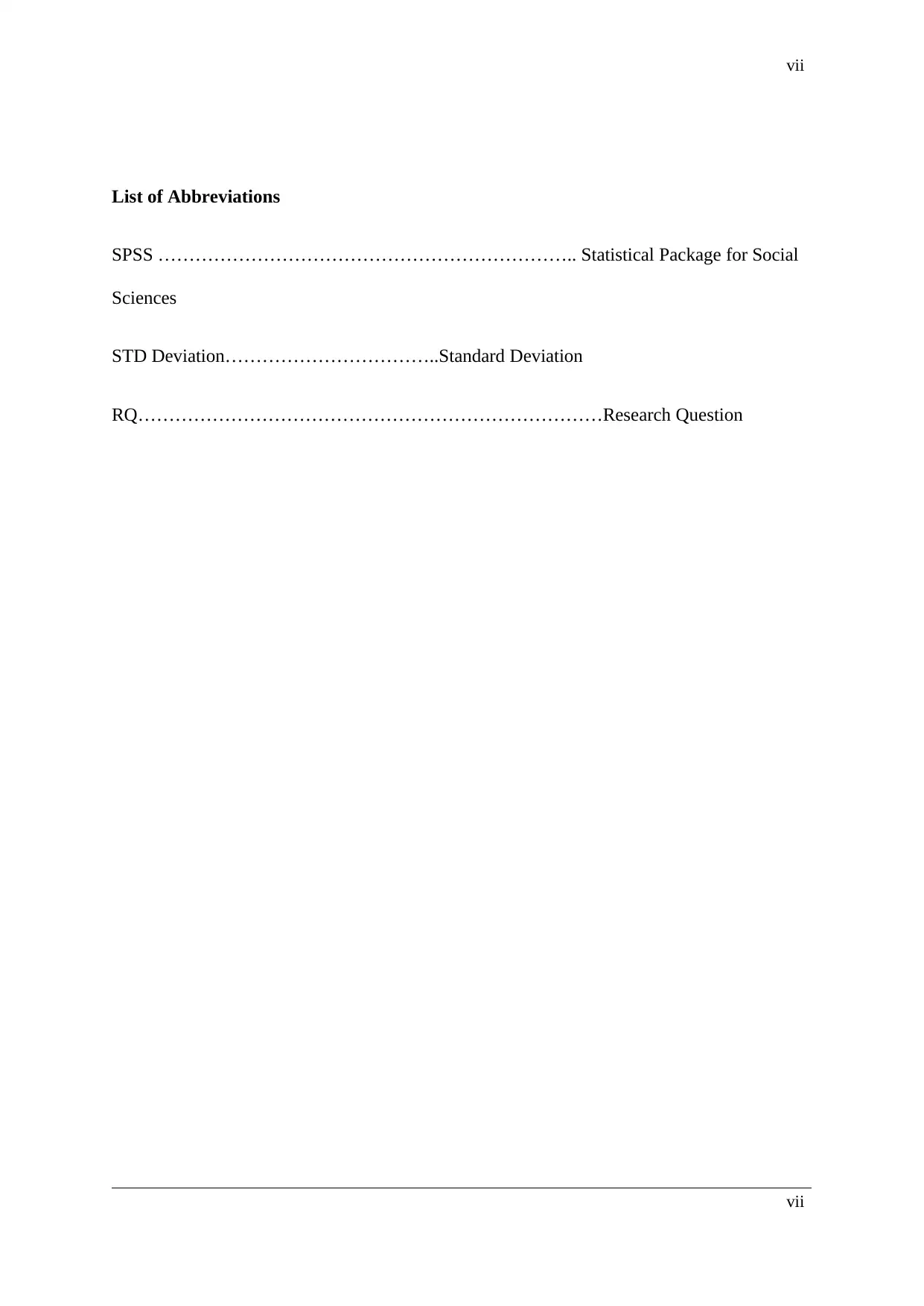
vii
List of Abbreviations
SPSS ………………………………………………………….. Statistical Package for Social
Sciences
STD Deviation……………………………..Standard Deviation
RQ…………………………………………………………………Research Question
vii
List of Abbreviations
SPSS ………………………………………………………….. Statistical Package for Social
Sciences
STD Deviation……………………………..Standard Deviation
RQ…………………………………………………………………Research Question
vii

viii
viii
viii
⊘ This is a preview!⊘
Do you want full access?
Subscribe today to unlock all pages.

Trusted by 1+ million students worldwide
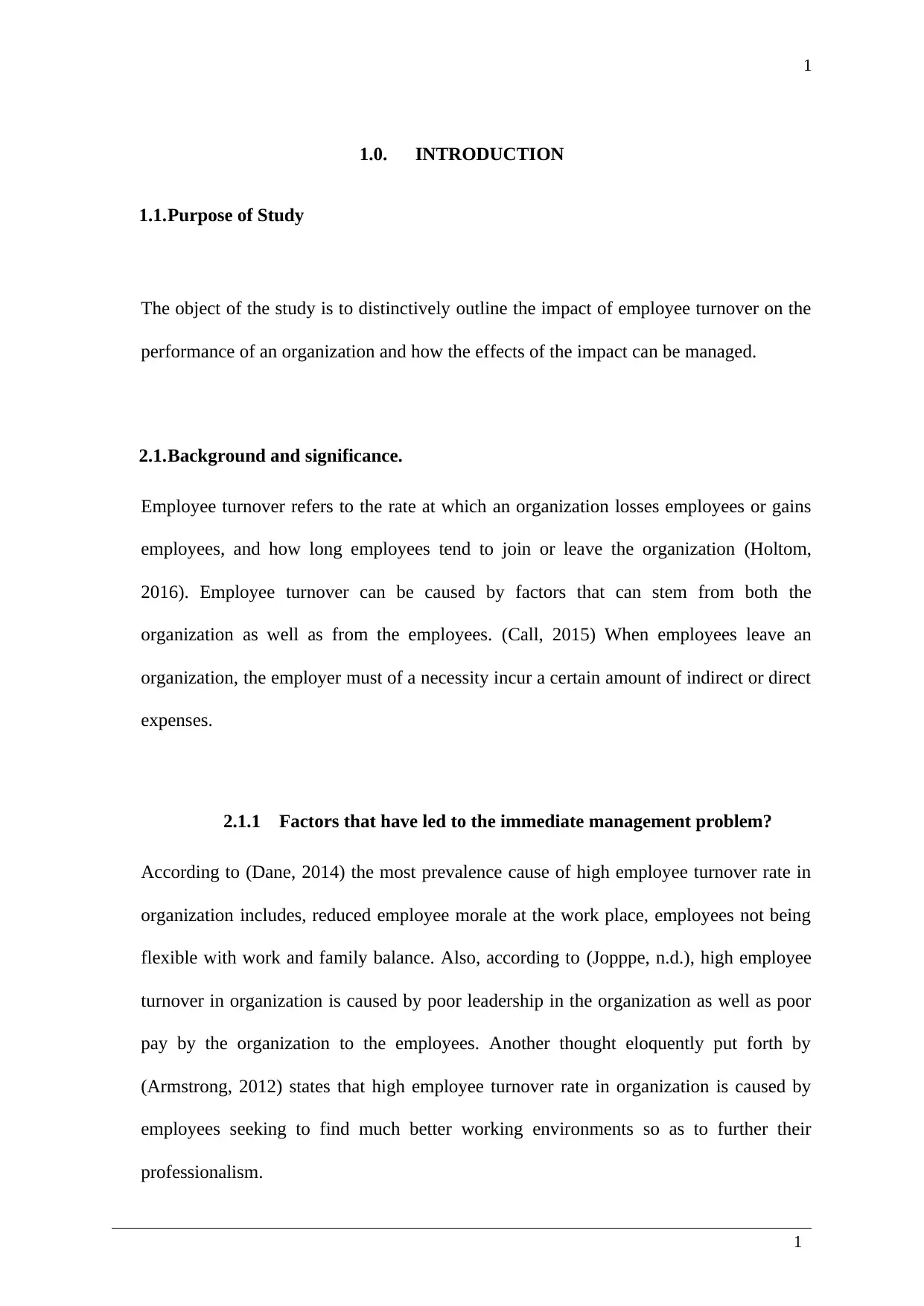
1
1.0. INTRODUCTION
1.1.Purpose of Study
The object of the study is to distinctively outline the impact of employee turnover on the
performance of an organization and how the effects of the impact can be managed.
2.1.Background and significance.
Employee turnover refers to the rate at which an organization losses employees or gains
employees, and how long employees tend to join or leave the organization (Holtom,
2016). Employee turnover can be caused by factors that can stem from both the
organization as well as from the employees. (Call, 2015) When employees leave an
organization, the employer must of a necessity incur a certain amount of indirect or direct
expenses.
2.1.1 Factors that have led to the immediate management problem?
According to (Dane, 2014) the most prevalence cause of high employee turnover rate in
organization includes, reduced employee morale at the work place, employees not being
flexible with work and family balance. Also, according to (Jopppe, n.d.), high employee
turnover in organization is caused by poor leadership in the organization as well as poor
pay by the organization to the employees. Another thought eloquently put forth by
(Armstrong, 2012) states that high employee turnover rate in organization is caused by
employees seeking to find much better working environments so as to further their
professionalism.
1
1.0. INTRODUCTION
1.1.Purpose of Study
The object of the study is to distinctively outline the impact of employee turnover on the
performance of an organization and how the effects of the impact can be managed.
2.1.Background and significance.
Employee turnover refers to the rate at which an organization losses employees or gains
employees, and how long employees tend to join or leave the organization (Holtom,
2016). Employee turnover can be caused by factors that can stem from both the
organization as well as from the employees. (Call, 2015) When employees leave an
organization, the employer must of a necessity incur a certain amount of indirect or direct
expenses.
2.1.1 Factors that have led to the immediate management problem?
According to (Dane, 2014) the most prevalence cause of high employee turnover rate in
organization includes, reduced employee morale at the work place, employees not being
flexible with work and family balance. Also, according to (Jopppe, n.d.), high employee
turnover in organization is caused by poor leadership in the organization as well as poor
pay by the organization to the employees. Another thought eloquently put forth by
(Armstrong, 2012) states that high employee turnover rate in organization is caused by
employees seeking to find much better working environments so as to further their
professionalism.
1
Paraphrase This Document
Need a fresh take? Get an instant paraphrase of this document with our AI Paraphraser
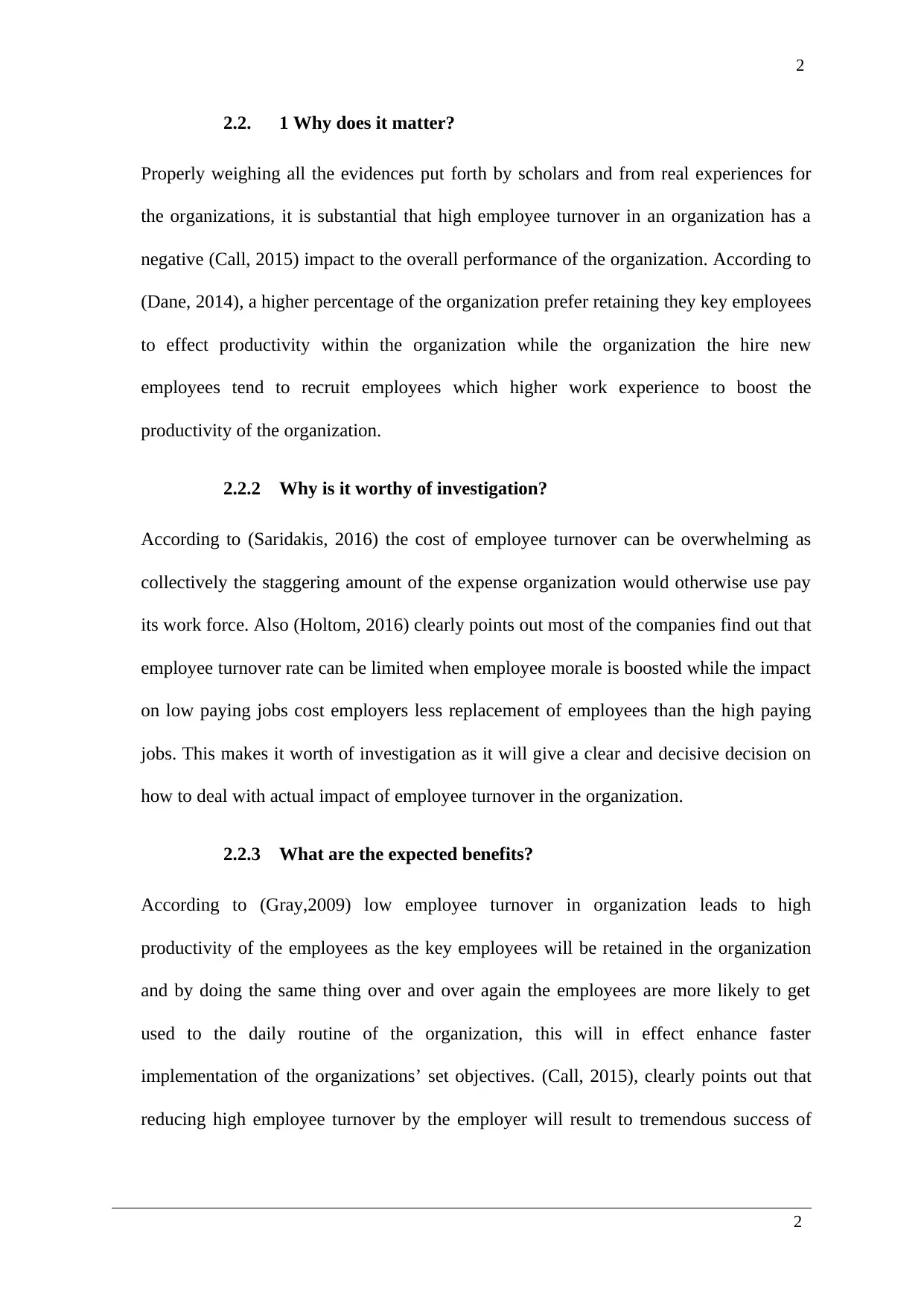
2
2.2. 1 Why does it matter?
Properly weighing all the evidences put forth by scholars and from real experiences for
the organizations, it is substantial that high employee turnover in an organization has a
negative (Call, 2015) impact to the overall performance of the organization. According to
(Dane, 2014), a higher percentage of the organization prefer retaining they key employees
to effect productivity within the organization while the organization the hire new
employees tend to recruit employees which higher work experience to boost the
productivity of the organization.
2.2.2 Why is it worthy of investigation?
According to (Saridakis, 2016) the cost of employee turnover can be overwhelming as
collectively the staggering amount of the expense organization would otherwise use pay
its work force. Also (Holtom, 2016) clearly points out most of the companies find out that
employee turnover rate can be limited when employee morale is boosted while the impact
on low paying jobs cost employers less replacement of employees than the high paying
jobs. This makes it worth of investigation as it will give a clear and decisive decision on
how to deal with actual impact of employee turnover in the organization.
2.2.3 What are the expected benefits?
According to (Gray,2009) low employee turnover in organization leads to high
productivity of the employees as the key employees will be retained in the organization
and by doing the same thing over and over again the employees are more likely to get
used to the daily routine of the organization, this will in effect enhance faster
implementation of the organizations’ set objectives. (Call, 2015), clearly points out that
reducing high employee turnover by the employer will result to tremendous success of
2
2.2. 1 Why does it matter?
Properly weighing all the evidences put forth by scholars and from real experiences for
the organizations, it is substantial that high employee turnover in an organization has a
negative (Call, 2015) impact to the overall performance of the organization. According to
(Dane, 2014), a higher percentage of the organization prefer retaining they key employees
to effect productivity within the organization while the organization the hire new
employees tend to recruit employees which higher work experience to boost the
productivity of the organization.
2.2.2 Why is it worthy of investigation?
According to (Saridakis, 2016) the cost of employee turnover can be overwhelming as
collectively the staggering amount of the expense organization would otherwise use pay
its work force. Also (Holtom, 2016) clearly points out most of the companies find out that
employee turnover rate can be limited when employee morale is boosted while the impact
on low paying jobs cost employers less replacement of employees than the high paying
jobs. This makes it worth of investigation as it will give a clear and decisive decision on
how to deal with actual impact of employee turnover in the organization.
2.2.3 What are the expected benefits?
According to (Gray,2009) low employee turnover in organization leads to high
productivity of the employees as the key employees will be retained in the organization
and by doing the same thing over and over again the employees are more likely to get
used to the daily routine of the organization, this will in effect enhance faster
implementation of the organizations’ set objectives. (Call, 2015), clearly points out that
reducing high employee turnover by the employer will result to tremendous success of
2
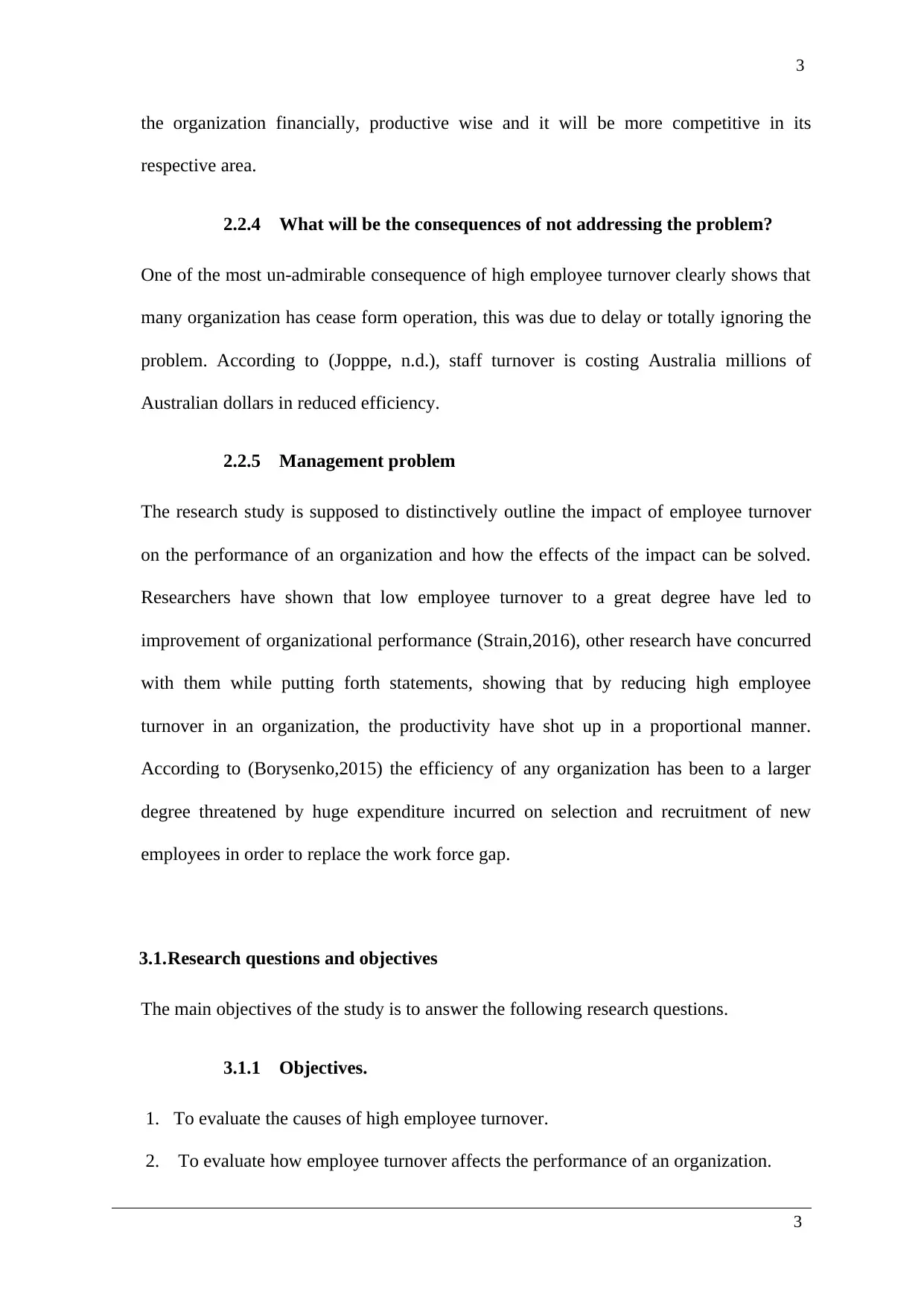
3
the organization financially, productive wise and it will be more competitive in its
respective area.
2.2.4 What will be the consequences of not addressing the problem?
One of the most un-admirable consequence of high employee turnover clearly shows that
many organization has cease form operation, this was due to delay or totally ignoring the
problem. According to (Jopppe, n.d.), staff turnover is costing Australia millions of
Australian dollars in reduced efficiency.
2.2.5 Management problem
The research study is supposed to distinctively outline the impact of employee turnover
on the performance of an organization and how the effects of the impact can be solved.
Researchers have shown that low employee turnover to a great degree have led to
improvement of organizational performance (Strain,2016), other research have concurred
with them while putting forth statements, showing that by reducing high employee
turnover in an organization, the productivity have shot up in a proportional manner.
According to (Borysenko,2015) the efficiency of any organization has been to a larger
degree threatened by huge expenditure incurred on selection and recruitment of new
employees in order to replace the work force gap.
3.1.Research questions and objectives
The main objectives of the study is to answer the following research questions.
3.1.1 Objectives.
1. To evaluate the causes of high employee turnover.
2. To evaluate how employee turnover affects the performance of an organization.
3
the organization financially, productive wise and it will be more competitive in its
respective area.
2.2.4 What will be the consequences of not addressing the problem?
One of the most un-admirable consequence of high employee turnover clearly shows that
many organization has cease form operation, this was due to delay or totally ignoring the
problem. According to (Jopppe, n.d.), staff turnover is costing Australia millions of
Australian dollars in reduced efficiency.
2.2.5 Management problem
The research study is supposed to distinctively outline the impact of employee turnover
on the performance of an organization and how the effects of the impact can be solved.
Researchers have shown that low employee turnover to a great degree have led to
improvement of organizational performance (Strain,2016), other research have concurred
with them while putting forth statements, showing that by reducing high employee
turnover in an organization, the productivity have shot up in a proportional manner.
According to (Borysenko,2015) the efficiency of any organization has been to a larger
degree threatened by huge expenditure incurred on selection and recruitment of new
employees in order to replace the work force gap.
3.1.Research questions and objectives
The main objectives of the study is to answer the following research questions.
3.1.1 Objectives.
1. To evaluate the causes of high employee turnover.
2. To evaluate how employee turnover affects the performance of an organization.
3
⊘ This is a preview!⊘
Do you want full access?
Subscribe today to unlock all pages.

Trusted by 1+ million students worldwide
1 out of 32
Related Documents
Your All-in-One AI-Powered Toolkit for Academic Success.
+13062052269
info@desklib.com
Available 24*7 on WhatsApp / Email
![[object Object]](/_next/static/media/star-bottom.7253800d.svg)
Unlock your academic potential
Copyright © 2020–2025 A2Z Services. All Rights Reserved. Developed and managed by ZUCOL.




